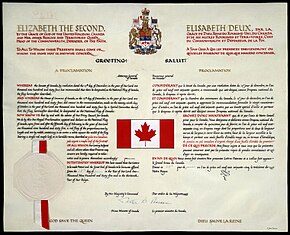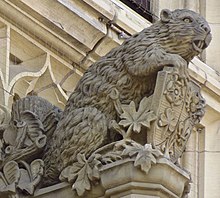National symbols of Canada – Wikipedia
Overview of the national symbols of Canada

Over the course of centuries, a multitude of national symbols and material items have arisen as uniquely Canadian or possessing uniquely Canadian characteristics. These symbols and items represent the culture of Canada—protectionism of that culture, identity, values, nationalism, and the heritage of its inhabitants.[1]
Themes and symbols of nature, pioneers, trappers, and traders played an important part in the early development of Canadian symbolism.[2] Modern symbols emphasize the country’s geography, cold climate, lifestyles, and the Canadianization of traditional European and indigenous symbols.[3]
A 2013 Statistics Canada survey found that more than 90% of those polled believed that the national flag and the Canadian Charter of Rights and Freedoms were the top symbols of Canadian identity. Next highest were the national anthem (“O Canada”), the Royal Canadian Mounted Police, and ice hockey.[4] A similar poll by Ipsos Reid in 2008 indicated that the maple leaf was the primary item that defines Canada, followed by ice hockey, the national flag, the beaver, the Canadarm, Canada Day, and Canadian Forces peacekeeping.[5] A poll taken in 2022 determined that 55 per cent of respondents agreed the country’s monarchy helps define Canadian identity and six in 10 felt it helps to differentiate Canada from the United States.[6]
Predominant symbols[edit]

Canada’s most well known symbol is the maple leaf, which was first used by French colonists in the 1700s.[8] Since the 1850s, under British rule, the maple leaf has been used on military uniforms and, subsequently, engraved on the headstones of individuals who have served in the Canadian Armed Forces.[9] The maple leaf is prominently depicted on the country’s current and previous flags and on the country’s coat of arms (or royal arms). The maple leaf has also been seen on the penny before circulation of that coin was stopped in 2013. Canada’s official tartan, known as the “Maple leaf tartan”, consists of four colours reflecting those of the maple leaf as it changes through the seasons—green in the spring, gold in the early autumn, red at the first frost, and brown after falling.[10]
Other prominent symbols include the national motto, A Mari Usque Ad Mare (From Sea to Sea),[11] the sports of hockey and lacrosse, the beaver, Canada Goose, Canadian horse, the Royal Canadian Mounted Police, the Canadian Rockies, the Canadian parliamentary complex, the Canadarm,[12] and, more recently, the Canadianization of totem poles and Inuksuks,[13] With material items such as Canadian beer, maple syrup, tuques, canoes, nanaimo bars, butter tarts, and the Quebec dish of poutine being defined as uniquely Canadian.[13][14] A six-pointed, hexagonal snowflake used as the insignia for the Order of Canada has come to symbolize Canada’s northern heritage and diversity.[15] The country’s institutions of healthcare, military peacekeeping, the national park system, and the Charter of Rights and Freedoms are seen as uniquely Canadian by its citizens.[16][17]
I treasure my place in the life of Canada and my bond with Canadians everywhere […] It is my privilege to serve you as Queen of Canada to the best of my ability, to play my part in the Canadian identity, to uphold Canadian traditions and heritage, to recognize Canadian excellence and achievement, and to seek to give a sense of continuity in these exciting, ever-changing times in which we are fortunate enough to live.[18]
Elizabeth II, Queen of Canada, Vancouver, British Columbia, October 2002
The Crown, displaying traditional cross pattées and fleurs-de-lis, symbolizes the Canadian monarchy[19] and appears on the coat of arms, the governor general’s flag,[19] the coats of arms of many provinces and territories; the badges of several federal departments, the Canadian Armed Forces and Royal Military College of Canada, many regiments, police forces, on buildings, as well as some highway signs and licence plates. Also, the image of Queen Elizabeth II (Canada’s erstwhile monarch) is on Canadian stamps, $20 bank notes, and all coins.
Official and de facto symbols[edit]
The following is a list of official and de facto symbols, as recognized by the government of Canada.[20] They are not shown in any order of precedence.
See also[edit]

References[edit]
- ^ Michael Dawson; Donald A. Wright; Catherine Anne Gidney (2018). Symbols of Canada. Between the Lines. p. 32. ISBN 978-1-77113-371-5.
- ^ “Canada in the Making: Pioneers and Immigrants”. The History Channel. August 25, 2005. Retrieved November 30, 2006.
- ^ Cormier, Jeffrey. (2004). The Canadianization Movement: Emergence, Survival, and Success. 10.3138/9781442680616.
- ^ “The Daily — Canadian identity, 2013”. www.statcan.gc.ca. Retrieved January 10, 2015.Canadian Identity, 2013 – By Maire Sinha
- ^ Defining Canada: A Nation Chooses The 101 Things That Best Define Their Country “Unprecedented, Definitive National Survey Identifies Top People, Places, Events, Accomplishments and Symbols that Define Canada. As Chosen By Canadian. Ipsos Reid on behalf of the Dominion Institute and the Department of
Citizenship and Immigration Canada, 2008. PDF version - ^ “Canadians Conflicted on Future Role of Monarchy as Half (54%) Say Canada Should End Ties to Monarchy”. Archived from the original on September 21, 2022. Retrieved September 21, 2022.
- ^ Monaghan, David (2013). “The mother beaver – Collection Profiles”. The House of Commons Heritage. Archived from the original on December 22, 2015. Retrieved December 12, 2015.
- ^ “Unofficial symbols of Canada”. The Department of Canadian Heritage. Retrieved 2019-01-01.
- ^ Michael Dawson; Donald A. Wright; Catherine Anne Gidney (October 15, 2018). Symbols of Canada. Between the Lines. ISBN 978-1-77113-371-5.
- ^ “Maple Leaf Tartan becomes official symbol”. Toronto Star. Toronto. March 9, 2011.
- ^ Reingard M. Nischik (2008). History of Literature in Canada: English-Canadian and French-Canadian. Camden House. pp. 113–114. ISBN 978-1-57113-359-5.
- ^ Canadian Heritage (2002). Symbols of Canada. Canadian Government Publishing. ISBN 978-0-660-18615-3.
- ^ a b Sociology in Action, Canadian Edition, 2nd ed. Nelson Education-McGraw-Hill Education. p. 92. ISBN 978-0-17-672841-0.
- ^ Hutchins, Donna; Hutchins, Nigel (2006). The Maple Leaf Forever: A Celebration of Canadian Symbols. Erin: The Boston Mills Press. p. iix intro. ISBN 978-1-55046-474-0.
- ^ “Canadian Honours > Order of Canada > Levels and Insignia”. The Governor General of Canada. 2002.
- ^ The Environics Institute (2010). “Focus Canada (Final Report)” (PDF). Queen’s University. p. 4 (PDF page 8). Archived from the original (PDF) on February 4, 2016. Retrieved December 12, 2015.
- ^ Nanos Research (October 2016). “Exploring Canadian values” (PDF). Archived from the original (PDF) on April 5, 2017. Retrieved February 1, 2017.
- ^ Memorable Quotations About Canada’s Monarchy, Monarchist League of Canada, retrieved 6 March 2023
- ^ a b c d “The Crown in Canada”. Department of Canadian Heritage. Archived from the original on 2011-08-27. Retrieved 2011-07-27.
- ^ a b c d e f g h i j k l m n o p q r s t u v w x y z aa ab ac Canadian Heritage (2002). Symbols of Canada. Canadian Government Publishing. ISBN 978-0-660-18615-3. Unofficial symbols of Canada, Official symbols of Canada, Royal symbols and titles
- ^ General, The Office of the Secretary to the Governor. “Governor General of Canada [Civil Institution]”. reg.gg.ca.
- ^ Heritage, Canadian (September 8, 2022). “Transition of the Crown — what it means for Canadians”. www.canada.ca.
- ^ “The arms of Canada”. Department of Canadian Heritage. Archived from the original on 2009-02-28. Retrieved 2011-07-27.
- ^ a b “Official symbols: Design Standard for the Federal Identity Program”. www.canada.ca. Treasury Board of Canada. 13 December 2021. Retrieved 18 February 2023.
- ^ Heritage, Canadian (11 August 2017). “Royal Anthem”. aem.
‘O Canada’ and ‘God Save the Queen’/’Dieu sauve la Reine’ were approved by Parliament in 1967 as Canada’s national and royal anthems. However, legislation to this effect was passed only in 1980, and applied only to ‘O Canada.’
- ^ “National Sports of Canada Act, CHAPTER N-16.7”. Code of Canada. Government of Canada. 12 May 1994. Archived from the original on 19 April 2012.
Further reading[edit]
External links[edit]
Recent Comments